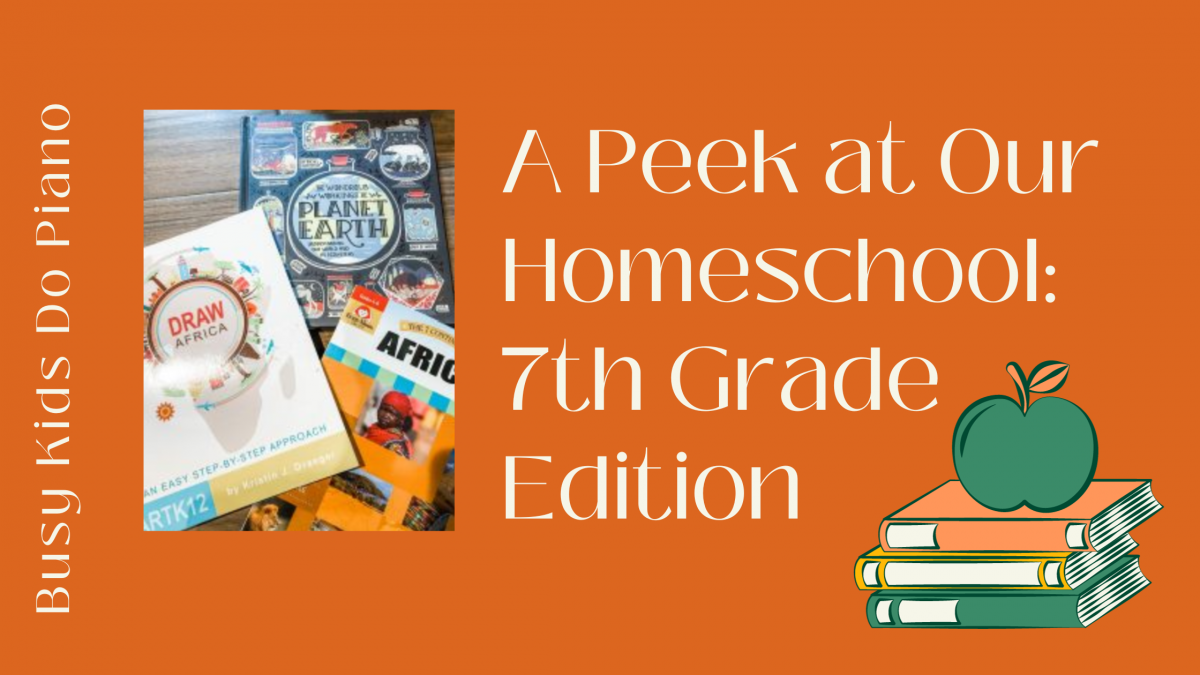In case you’re new here, we take what is called an eclectic approach to homeschooling. This means we don’t follow one set philosophy such as Classical Conversations. It also means we don’t use one boxed curriculum that overs every subject. Instead, I have picked out parts from different homeschooling resources that I believe best fit my daughter’s personality and interests.
My rising 7th’s main interests are science (mainly environmental science) and reading, so you’ll see that reflected in both how we structure things and the materials we use for learning. She also learns best by hands-on activities.
Below is the quick version of what we’re using for 7th grade. For more detailed explanations, scroll on down!
Literature: Units from Brave Writer (individual books, poems, etc. listed in more detail below) and Fishtank Learning
Math: Saxon Algebra 1/2 with Nicole the Math Lady and When Math Matters by Edward Zaccaro
Science: Exploring Creation with Chemistry and Physics by Jeannie K. Fulbright
Social Studies: History: From the Dawn of Civilization to the Present Day by Smithsonian Institution and World History Detective
Geography/Ecology: Draw Africa by Kristin J. Draeger, Africa by Evan-Moor, The Wondrous Workings of Planet Earth: Understanding Our World and its Ecosystems by Rachel Ignotofsky, Survival Camp by Bear Grylls
Latin: Second Form Latin by Memoria Press
Music: Busy Kids Do Piano, Busy Kids Love Music podcast
Grammar/Writing: Weekly class at a co-op
Art: Co-op
Speech/Debate: Co-op
Random Other Things: Listed in more detail below 🙂
Literature: Brave Writer and Fishtank Learning
My daughter loves to read — and reads quite a lot of books on a variety of topics. For literature selections, I try to incorporate many different types of literature from a diverse authorship. Here’s what I’ve selected for this year (affiliate links are included):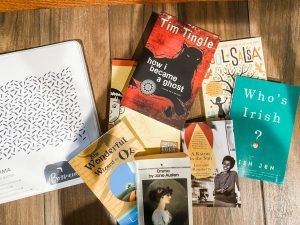
- Emma by Jane Austen (study from Brave Writer) novel
- American Born Chinese by Gene Luen Yang (study from Brave Writer) graphic novel
- Wizard of Oz by L. Frank Baum (study from Brave Writer) novel
- How I Became A Ghost by Tim Tingle (study from Brave Writer) novel
- A Raisin in the Sun by Lorraine Hansberry (study from Fishtank Learning) drama
- Poems, short stories and essays that focus on the diversity of the American experience (loosely based on this study from Fishtank Learning)
One of our favorite things we implemented in homeschool last year was Poetry Tea Time. We decided to up our Tea Party game this year, and after we finish each novel, we’ll be visiting a different tea house in our area, and read/discuss poetry inspired by our novel. For example, after reading How I Became A Ghost by Tim Tingle, an enrolled member of the Choctaw Nation, we will read poems by indigenous poets during that poetry tea time. After reading American Born Chinese, we’ll read/discuss works by Asian American poets.
Math: Saxon Algebra 1/2 with Nicole the Math Lady and When Math Matters by Edward Zaccaro
Confession: I hate teaching math. When we finished up the Singapore math series, I really, really wanted to figure out a way to outsource math as we headed into pre-algebra. A friend recommended Nicole the Math Lady online classes to me, and it has been a total game changer (we started in the last couple months 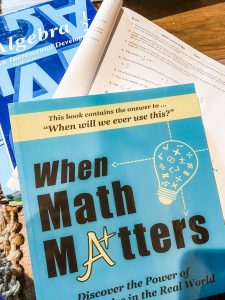 of the school year). Her lessons are clear and engaging and the program has all the support built in if my daughter has questions. I even signed up for the version that grades everything for me, so it’s completely freed me up from this dreaded subject. Ever couple of weeks, we throw in a lesson from When Math Matters by Edward Zaccaro for some fun, real-life problems (for example, figuring out if you really got a good deal when purchasing tires) just so my daughter continues to understand the relevancy and application of what she’s learning.
of the school year). Her lessons are clear and engaging and the program has all the support built in if my daughter has questions. I even signed up for the version that grades everything for me, so it’s completely freed me up from this dreaded subject. Ever couple of weeks, we throw in a lesson from When Math Matters by Edward Zaccaro for some fun, real-life problems (for example, figuring out if you really got a good deal when purchasing tires) just so my daughter continues to understand the relevancy and application of what she’s learning.
Science: Exploring Creation with Chemistry and Physics
Last year was our first year using a science curriculum from Apologia, and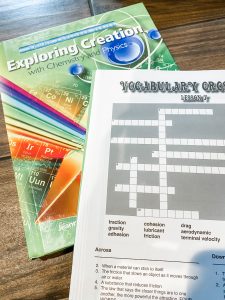 we so enjoyed all the hands-on learning activities and experiments. We’re eager to get started with this year’s textbook and notebooking journal, and I can tell you with all certainty that my daughter’s favorite science project is going to be baking a sugar cookie periodic table. (Pro tip: If the idea of tons of experiments scares you, check out the lab kits that accompany these books from Rainbow Resources. It makes it so much easier to prep for all the projects!)
we so enjoyed all the hands-on learning activities and experiments. We’re eager to get started with this year’s textbook and notebooking journal, and I can tell you with all certainty that my daughter’s favorite science project is going to be baking a sugar cookie periodic table. (Pro tip: If the idea of tons of experiments scares you, check out the lab kits that accompany these books from Rainbow Resources. It makes it so much easier to prep for all the projects!)
Social Studies: History: From the Dawn of Civilization to the Present Day by Smithsonian Institution and World History Detective
My daughter adores social studies, and I’ve found that using one main book as our spine, but really branching out to do fun projects and field trips, watching documentaries and reading biographies about interesting historical figures has 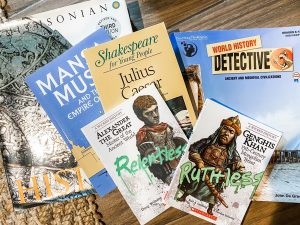 been key to making it one of her favorite subjects (she will quickly remind you that when she attended traditional school, she HATED social studies class). We’re using the two books listed above as our “textbooks” and guide. While the Smithsonian book is filled with incredible visuals, time lines and tidbits, the World History Detective from Critical Thinking Co. is more workbook style, with things like concept maps and written response questions. We’re working our way through Ancient and Medieval history, and you can see in the photo some of the supplementary biographies and books we’re adding to the “textbooks” for our study on Antiquity. (I’m still working on finding supplemental bios and books for Medieval history!)
been key to making it one of her favorite subjects (she will quickly remind you that when she attended traditional school, she HATED social studies class). We’re using the two books listed above as our “textbooks” and guide. While the Smithsonian book is filled with incredible visuals, time lines and tidbits, the World History Detective from Critical Thinking Co. is more workbook style, with things like concept maps and written response questions. We’re working our way through Ancient and Medieval history, and you can see in the photo some of the supplementary biographies and books we’re adding to the “textbooks” for our study on Antiquity. (I’m still working on finding supplemental bios and books for Medieval history!)
Geography/Ecology: Draw Africa by Kristin J. Draeger, Africa by Evan-Moor, The Wondrous Workings of Planet Earth: Understanding Our World and its Ecosystems by Rachel Ignotofsky, Survival Camp by Bear Grylls
I know you’re probably thinking this is a ridiculous amount of books and 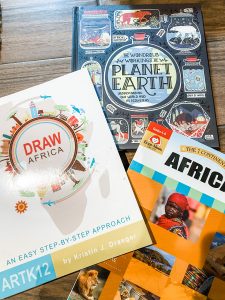 that I’m overworking my child, so let me explain! Environmental studies are really my daughter’s main love, and at this point in her life she is exploring paths towards becoming an ornithologist or wildlife scientist. So while we study “traditional” geography, we’re also exploring the world with the desire to learn more about why the geography is the way that it is in each region, and how that supports and influences the life there — which is why I’m calling this ecology, too!
that I’m overworking my child, so let me explain! Environmental studies are really my daughter’s main love, and at this point in her life she is exploring paths towards becoming an ornithologist or wildlife scientist. So while we study “traditional” geography, we’re also exploring the world with the desire to learn more about why the geography is the way that it is in each region, and how that supports and influences the life there — which is why I’m calling this ecology, too!
We use the Draw the World series by Kristin J. Draeger each year and map a different continent, and this year she’ll be working on drawing a map of Africa while also developing some geographical literacy with the activities in the Evan-Moor workbook. She’ll really only spend about 15 minutes a week completing these assignments.
The super fun and interesting stuff for her will be the other two books. I discovered The Wondrous Workings of Planet Earth: Understanding Our World and its Ecosystems at a beautiful map store in Seattle this summer, and knew immediately that my daughter would love it. We’ll spend two years using this resource to tour the planet and learn about rainforests, reefs, deserts and more from this brilliant female scientist. I’ll probably throw in some documentaries that correspond with the various topics as we cover them.
I firs t learned of Bear Grylls’s Survival Camp book from Timberdoodle, and my daughter couldn’t wait until the beginning of the school year to crack it open so it’s already gotten some good use this summer! It’s filled with fascinating stories of expeditions in the wilderness throughout history and a whole section on navigating with or without a map. The book truly has everything from first aid tips to camel biology.
t learned of Bear Grylls’s Survival Camp book from Timberdoodle, and my daughter couldn’t wait until the beginning of the school year to crack it open so it’s already gotten some good use this summer! It’s filled with fascinating stories of expeditions in the wilderness throughout history and a whole section on navigating with or without a map. The book truly has everything from first aid tips to camel biology.
Latin: Second Form Latin by Memoria Press
We’re plugging away with our third year of Latin using this curriculum from Memoria Press. My husband is the Latin scholar in the house, so he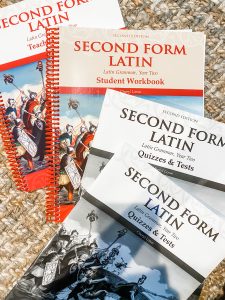 works with our kiddo on a new lesson each week (the series includes video classes for those who don’t have a Latin background), and then she completes the worksheets and quizzes independently during the week. It’s another class where I get to be very hands-off!
works with our kiddo on a new lesson each week (the series includes video classes for those who don’t have a Latin background), and then she completes the worksheets and quizzes independently during the week. It’s another class where I get to be very hands-off!
Music: Busy Kids Do Piano, Busy Kids Love Music podcast
Since I put my heart and soul into my piano lesson resources, of course I use them for my own daughter! The Busy Kids Love Music podcast episodes are such a simple way to incorporate music history/appreciation into our week, and we can listen to them while driving to various activities. Since my daughter plays trumpet in a weekly homeschool band, our piano lessons have become a little less regular, but we do still strive to have a piano lesson about every other week, working through my Busy Kids Do Piano curriculum.
RANDOM OTHER THINGS
I love scouring the Timberdoodle site for other supplementary things that I know my daughter will enjoy if she has downtime, or if I need her to work on something independently for a bit. The Thinking Toolbox is a super fun 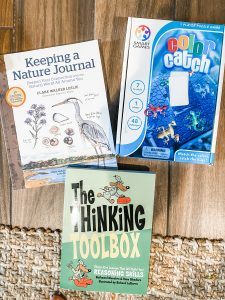 critical thinking/logic book with brief lessons to work through and Color Catch has brain teasers she enjoys tackling.
critical thinking/logic book with brief lessons to work through and Color Catch has brain teasers she enjoys tackling.
We treasure Clare Walker Leslie’s nature books, and are adding this one to our collection this year. My daughter and I came up with something we’ve decided to call The Green Hour. Each week, she’ll spend an hour outdoors working on her nature journal.
The list above obviously includes a lot of BOOKS, but I do want to note that we don’t spend our days simply reading books (though we do like to do plenty of that, too!). I plan our homeschool calendar in two month increments, and schedule in about four or five “flex days” for field trips and volunteering. (Next month, we’re heading on a bird walk with our local Audubon chapter and visiting a Biblical History Center.) We read poetry over tea and pastries and we watch a movie based on a book we read to see how it compares. One thing I’ve learned is that there is so much beauty in the together-ness that is a part of homeschooling, and it is so important to me to make sure we spend time absorbing the gift and magic of it without getting lost in a workbook.
Wishing you a magical school year!

